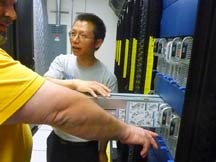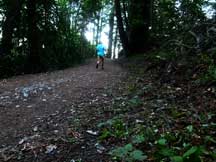June 12 was the celebration of the launch of the newest UCSC "Science Hill" supercomputer - the "Hyades" (~10x faster and bigger than predecessor Plieades) and recently acquired Huawei astrophysics data storage system for researchers in the Departments of Astronomy and Astrophysics, as well as Applied Mathematics and Statistics, Computer Sciences, Earth and Planetary Sciences, and Physics. It's a beast - with 376 Intel Sandy Bridge Xeon CPUs (3008 x64 cores in total), 8 Nvidia K20 GPU computing accelerators, 3 Intel Xeon Phi 5110P accelerators, 13 terrabytes of memory, and a peak speed of 60 TFLOPS. Two tiers of storage complement Hyades: a 150TB scratch storage (running Lustre file system) for data input and output when running simulations, and a 1 petabyte (that's a million gigabytes!) private cloud storage system (in collaboration with Huawei Technologies ) for data archival and data sharing with the community at large. Our host was project lead and friend Physics professor Joel Primack, who showed us around the hardware and explained the capabilities.
Where else can you do a run from home downtown, up along trails and single-tracks through redwood forests and fresh streams and springs to drink from along the way, to the top of the hills where the worlds #1 astronomical research institution and its people are, and back, in an afternoon? A nine mile run to satisfy the body and mind.
|
on one of the upper Pogonip trails |
|
Impressive runner's legs! (with a properly positioned wide angle lens, that is) |
Homeward, and off to the gym for a swim, then to Cabrillo College Observatory for an evening of testing out our new Nikon D7000 camera on tonight's occultation of the M67 star cluster |







